Scottish Health Survey 2015 - volume 2: technical report
Details of the methodology and fieldwork for the Scottish Health Survey 2015.
This document is part of a collection
9 Spot Urine
9.1 Introduction
Urine, a waste product of human bodily functioning, can be analysed to provide information on various factors depending on the compound to be analysed (Table 5). The information that is obtained is highly accurate and cannot be taken from any other source. Please note that the compounds that are analysed are dependent on the individual survey.
Table 5 Compounds in urine analysis
| Chemical |
Definition |
|---|---|
| Potassium |
Potassium is both an electrolyte and a mineral which works to keep a balance in bodily fluids and has an important role in nerve and muscle functioning. Potassium is found in fruit and vegetables and thus also indicates the fruit and vegetable intake of individuals. |
| Sodium (salt) |
Sodium is both an electrolyte and a mineral which works to keep a balance in bodily fluids and has an important role in nerve and muscle functioning. Sodium is found in most foods and has been shown to contribute to high blood pressure which is a major risk factor in the development of cardiovascular disease. |
| Urea and Nitrogen |
Urea and nitrogen are natural by-products of the human body. They are analysed to give an indication of kidney function. They also provide information on the amount of protein in an individual's diet. |
9.2 Exclusion criteria
Participants are excluded from giving a urine sample if they:
- Are pregnant
- Are HIV positive
- Have Hepatitis B or C
Do not ask for information regarding HIV and Hepatitis B or C, however if they volunteer it, record them as unable to give a sample and make a note.
Women who have their period are not excluded from giving a urine sample. Participants with a catheter are also not excluded. If the sample is taken from a catheter bag, this should be recorded in CAPI. It does not matter how long the urine has been in the collection bag.
Please Note: Interviewers are not expected to empty catheter bags.
Participants with catheters should be requested to empty a small amount of urine from their catheter bag into the plastic beaker themselves. The sample should then be collected as per protocol.
9.3 Consent
There is a separate consent form for the urine sample. This must be signed and dated by the Participant or by the parent/legal guardian in the case of Participants aged 15 years and below. Please make it clear to Participants that they will not receive results regarding their urine sample.
9.4 Equipment
You will need:
- A 100ml Polypropylene disposable beaker
- A 10ml Sarstedt urine collection syringe and extension tube containing a small amount of a preservative
- An instruction leaflet on how to use and fill the Sarstedt syringe
- Coloured labels
- Gloves
- A polythene bag to store the equipment in and can be used to discard the used equipment once the sample has been taken (optional).
9.5 Preparing the Participant
Explain to the Participant that you need a urine sample and why it is important. Explain the equipment to them and show them how to use the Sarstedt syringe. A demonstration consisting of a syringe and a beaker filled with water can be used for this purpose. The instruction leaflet, similar to Section 9.5.1, can be left with the Participant for easy reference while performing the urine collection in private, if required. Explain the procedure below to the Participant. Tell them that you need them to follow the procedure as carefully as possible.
9.5.1 Urine sample syringe instructions
1. Collect your sample in the disposable pot.
2. Remove the small push cap
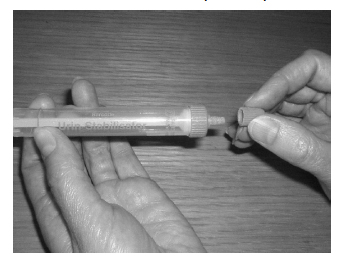
3. Push the extension tube on the syringe nozzle.
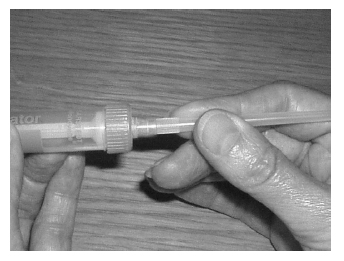
4. Put the end of the tube into the urine in the beaker and pull back the syringe to fill it.
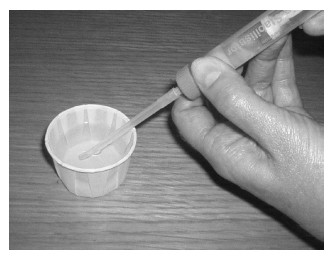
5. Remove the extension tube.
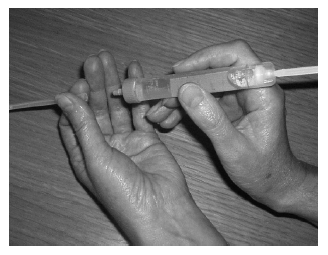
6. Replace the cap.

7. Pull the syringe plunger until it clicks and break off the stalk.
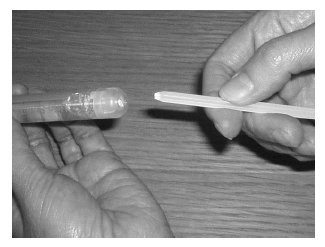
NB: Person in pictures should be wearing gloves!
9.6 Procedure
1. Participants are to wash their hands with soap and water prior to voiding to avoid contaminating the sample with substances which may be on their hands. It is important that the inside of the urine collection beaker is not touched or allowed to come into contact with any part of the Participant's body, clothing or any external surfaces.
2. Ask the Participant to collect a mid flow sample of their urine in the disposable collection beaker.
3. Immediately after voiding they need to collect a sample of the urine by using the syringe as you have demonstrated to them and by following the instructions on the card. The collection of the urine sample needs to happen immediately after voiding to minimise specimen exposure to air.
4. Ask the Participant to wash the outside of the filled and sealed syringe and dry it using toilet roll, once the sample collection is complete.
5. If the Participant is unable to fill the syringe him/herself, or would rather not do so, you can do this for them. Emphasise that the sample needs to be taken from the sample straight away in order to minimise specimen exposure to air, so as soon as they have finished they need to bring it to you or leave it in the bathroom and notify you that the sample is ready. Please ensure that you are wearing gloves before attempting to fill the syringe for this Participant, you should wear gloves at all times when you come in contact with a urine sample.
6. Make sure that the plastic cap is securely sealed and the syringe plunger stalk snapped.
7. Label and package the sample according to the project specific instructions.
8. To dispose of the sample, pour the remaining urine in the toilet and throw the beaker and used equipment in the rubbish bin (if the Participant prefers, this can be put in a polythene bag first and then thrown in the rubbish bin).
Contact
Email: Julie Landsberg, julie.landsberg@gov.scot
There is a problem
Thanks for your feedback